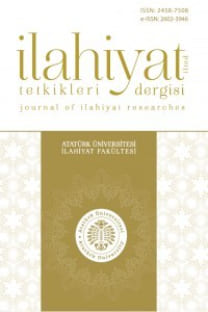“Ben”i Aramak İçin Bir Yolculuk: Şebüsterî’nin Gülşen-i Râz’ında “Ben” Kavramı
Metafizik, Maḥmūd Shabistarī, Gülşen-i Rāz, Sufizm, Benlik, İlâhî Tecellî
A Journey in Search of “I”: The Self in Shabistarī’s Rose Garden of Mystery (Gulshan-i Rāz)
Metaphysics, Maḥmūd Shabistarī, The Rose Garden of Mystery (Gulshan-i Rāz), Sufism, Self, Manifestation,
___
- Apaydın, Yasin. Tabatabaî’de Varlık Felsefesi. ed. Sedat Baran. Istanbul: Önsöz Yayıncılık, 2019.
- Barzegar Khaleqi, Muḥammad Reza. Rāzhāyī Az Gulshan-i Rāz. Tehran: Zawwar Publications, 2019.
- Ermiş, Fatih. “Bin Altınlık Hazine: Gülşen-i Râz Önemi, Hakkındaki Literatür, Ele Aldığı Belli Başlı Konular”. Türkiye Araştırmaları Literatür Dergisi 15/30 (2017), 155–180.
- Hadot, Pierre. Plotinus or the Simplicity of Vision. trans. Michael Chase. Chicago: Chicago University Press, 1998.
- Ḥusseinī Ṭehrānī, Sayyid Muḥammad Ḥussein. Mehr-i Tābān. Mashhad: Mashhad University Press, 8th Edition, 2005.
- Ibn ʿArabī, Abū ʿAbd Allāh Muḥammad. al-Risālat al-Wujūdiyyah. Beirut: Dar Al-Kotob Al-ilmiyah, 2004.
- Ibn ʿArabī, Abū ʿAbd Allāh Muḥammad. Fuṣūṣ al-Ḥikam. Critical ed. Samad Muwahhid. trans. Muḥammad Ali Muwahhid. Tehran: Nashr Karnameh Publications, 1427/2006.
- Ibn Turka Iṣfahānī, Ṣāʾin al-Dīn. Sharḥ-i Gulshan-i Rāz. ed. Kazem Dezfoulian. Tehran: Afarinesh Publications, 1996.
- Jaʿfarī Tabrīzī, Muḥammad Taqī. ʿIrfān-i Islāmī. ed. Abd Allah Nasri. Tehran: Islamic Culture Broadcasting Institute, 2022.
- Jāmī, ʿAbd al-Raḥmān bin Aḥmad. Naqd al-nuṣūṣ fi sharḥ-i naqsh al-fuṣūṣ. Critical ed. William Chittick. Tehran: The Institute for Cultural Studies of Ministry of Culture and Higher Education, 2nd Edition, 1992/1412.
- Lāhījī, Shams al-Dīn Muḥammad. Mafātīḥ Al-Iʿjāz fī Sharḥ-i Gulshan-i Rāz. ed. Muḥammad Reza Barzegar Khaleqi - Effat Karbasi. Tehran: Zawwar Publications, 2016.
- Narāqī, Mullā Aḥmad. Miʿrāj al-saʿādah. Mashhad: Beh Nashr Publications, 2012.
- Nasr, Seyyed Hossein et al. The Study Quran: A New Translation and Commentary. New York: Harper Collins Publishers, 2015.
- O’Brien, Elmer. The Essential Plotinus. Indianapolis: Hackett Publishing Company, 1964.
- Plotinus. Plotinus: The Enneads. ed. Lloyd P. Gerson. Cambridge: Cambridge University Press, 2018.
- Rabbānī-Golpāyegānī, ʿAlī. Iḍāḥ al-ḥikmah. 4 Volumes. Qum: The Global Center for the Islamic Studies, 1992. Rahbari Ghazani, Rasoul. The Oneness of Being in Ibn ‘Arabī and Plotinus. ed. Asım Kaya. Ankara: Eskiyeni Publications, 2022.
- Rūmī, Mawlānā Jalāl al-Dīn Muḥammad Balkī. Kulliyyāt-i Shams Tabrīzī. Tehran: Doostaan Publications, 7th Edition, 2020.
- Rūmī, Mawlānā Jalāl al-Dīn Muḥammad Balkī. Mathnawī Maʿnawī. Tehran: Payam Edalat, 11th Edition, 2021.
- Rūmī, Mawlānā Jalāl al-Dīn Muḥammad Balkī. Sharḥ-i Jāmeʿ-i Mathnawī Maʿnawī (Daftar-i Awwal). 7 Volumes. Critical ed. Karim Zamani. Tehran: Ettelaat Publications, 55th Edition, 1442/2021.
- Sabziwārī Khorāsānī, Mullā Muḥammad Ibrāhīm. Sharḥ-i Gulshan-i Rāz. ed. Parviz Abbasi Dakani. Tehran: Ilm Publications, 2008.
- Sadafi, Mahdi – Hosseini Shahroudi, Morteza. “Chegūnegī-i Aʿyān-i Thābitah Dar Fanāʾ-i Dhātī: Barrasī-i Munāẓere-i ʿAllāmah Ṭabāṭabāʾī Wa ʿAllāmah Ṭehrānī”. Esra Hikmat 4/18 (2014), 125-149.
- Shabistarī, Sʿad al-Dīn Maḥmūd. Gulshan-i Rāz. ed. Muḥammad Reza Barzegar Khaleqi. Tehran: Zawwar Publications, 2017.
- Shabistarī, Sʿad al-Dīn Maḥmūd. Matn Wa Sharḥ-i Gulshan-i Rāz. Critical ed. Kazem Dezfoulian. Tehran: Talaye Publications, 3rd Edition. 1431/2010.
- Ṭabāṭabāʾī, Muḥammad Ḥusayn. Bidāyat al-ḥikmah. Lebanon: Dār al-Taʿāruf lil-Maṭbuʿāt, 2011.
- Yasrebi, Seyyed Yahya. Falsafa-i ʿIrfān. Qum: Qum Islamic Preaching Center, 1411.
- ISSN: 2458-7508
- Yayın Aralığı: 2
- Başlangıç: 1975
- Yayıncı: Atatürk Üniversitesi
İran'da Faaliyet Yürüten Nakşibendî- Hâlidî Şeyhlerinin Sünnî Kültüre Katkısı
Sonsuz ile Sonlu Olanın Sürekliliği: Eş‘arî Kelâmında Bekâ Tartışmaları
Elias Wang and His Method of Interpretation İlyas-Wang ve Tefsir Yönteminin Analizi
“Ben”i Aramak İçin Bir Yolculuk: Şebüsterî’nin Gülşen-i Râz’ında “Ben” Kavramı
Rasoul RAHBARI GHAZANI, Saliha UYSAL
Tanrı ve Çocuk: Çocukların Tanrı Algıları ve Bilişsel Evre Teorilerinin Çıkmazı
Arap Dilinde Muktezây-ı Hâl ve Önvarsayım İlişkisi
